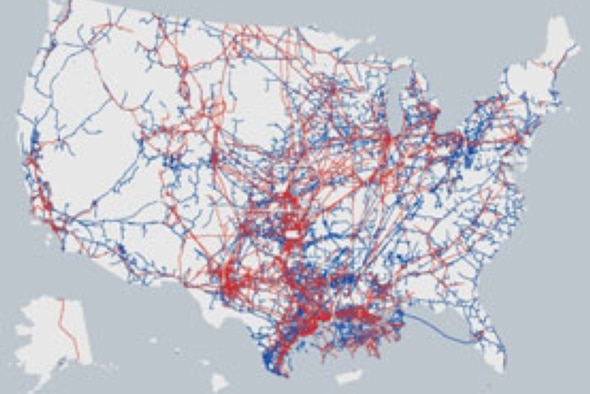Maryland is the third state to ban fracking, after New York and Vermont did a couple of years ago.
In a rare case of bipartisanship, Maryland’s Republican Governor, Larry Hogan, signed a bill passed overwhelmingly by the Democratically controlled legislature. He says, “The possible environmental risks of fracking simply outweigh any potential benefits. Protecting our clean water supply and our natural resources is critically important to Marylanders and we simply cannot allow the door to be open for fracking in our state.”
Activists have been pushing for a ban since 2012. Food & Water Watch talks about how it came to fruition. After lots of rallies and knocking on doors, they say: “In March of 2013, we helped pass a ban on fracking wastewater in the Baltimore City Council, and in 2014, we worked with Montgomery County to ban fracking there. When the state legislature passed a fracking moratorium in 2015, things really started to pick up steam. Working with partners, we passed fracking bans in Prince George’s County, Anne Arundel County, Baltimore City and Friendsville in Garrett County. We also passed fracking resolutions in Frederick County and about a dozen other jurisdictions across the state. These local actions brought thousands of people into the anti-fracking movement, and set us up to win big at the state level.”
138 communities in the US have banned fracking, including Los Angeles, Mendocino, San Benito, Santa Cruz and Butte counties in California and Cincinnati and Athens in Ohio. Colorado has been at outlier, suing towns that have passed bans.
In the past, Hogan called fracking an economic goldmine, so we’re not sure what changed his mine – especially since he vetoed a bill to expand renewable energy in Maryland. Democrats overrode the veto, raising the state’s Renewable Portfolio Standard to 25% renewables by 2020, up from 20% by 2022. A bill to expand energy efficiency – utilities must cut electricity demand 2% a year by 2020 – became law without the Governor’s signature.
Pipeline Spills All Too Common
Banning fracking is completely separate from the threat of pipelines, however. Even with 2.7 million miles of oil and gas pipelines across the US, there are plans for 9,000 more miles, according to The Gas Rush: Locking America into Another Fossil Fuel for Decades, by Sierra Club. 19 new pipelines are planned for Appalachia alone, and fights are on-going in 10 states.
Bayou Bridge pipeline, for example, would connect refineries in Louisiana with North Dakota oil fields, putting 700 watersheds at risk. And a bill introduced in the House would allow oil and gas drilling in 40 National Parks!
Last week, New York denied a permit for the Northern Access Pipeline – which would have stretched from Pennsylvania to Canada – after turning down another pipeline last year. Portland, Oregon passed a resolution that bars new fossil infrastructure and new terminals are blocked in Vancouver, Washington. 28 pipelines, oil-by-train, and terminals have been stopped by activism and market conditions.

Center for Biological Diversity
Incredibly, only 528 government employees are in charge of inspecting pipelines – one inspector per 5,000 miles of pipelines. The Pipeline and Hazardous Materials Safety Administration is severely understaffed with just 188 inspectors (the rest are state employees) and is due for big budget cuts under Trump. Inspectors are also responsible for 148 liquefied natural gas (LNG) plants and 418 gas storage facilities, many of them old and deteriorating.
About 16% of fracked gas wells rupture per year according to a new study published in Environmental Science & Technology. Over the past 10 years, there have been 6,648 spills in Colorado, New Mexico, North Dakota and Pennsylvania alone, where there are 31,481 wells. Half the spills are from pipelines and poor storage and the rest from failed equipment and loading/unloading trucks.
Since 2009, over 175 million gallons of wastewater spilled from ruptured pipes, overflows from storage tanks and even deliberate dumping,” reports Associated Press, poisoning agricultural land and drinking water, and causing mass die-offs of plant and animals. There have been almost 22,000 spills in 11 states.
Watch this time-lapse video that shows significant spills since 1986 – causing a total $7 billion in damages, over 2,000 injuries and more than 500 deaths. All told, 3 million gallons have spilled every year.
How About Offshore?
Fracking is also happening in the Gulf of Mexico. With a court order in hand, the Center for Biological Diversity found that 1200 fracking permits were issued by the Obama administration’s Bureau of Ocean Energy Management and the EPA allowed the wastewater dumped in the Gulf – without environmental review, public input or monitoring. It’s also been occurring in federal waters off California.
“Fracking has largely been in a shroud of secrecy,” says Miyoko Sakashita, the group’s Oceans Director. “Even regulators, until recently, were not really aware it was happening. The EPA doesn’t know which chemicals are being discharged into the Gulf of Mexico.”
76 billions gallons of wastewater were dumped in the Gulf in 2014 alone. On land, the EPA requires wastewater to be relatively clean before it goes into streams, for example, but there are no rules offshore. They don’t even keep track of wastewater dumping offshore, Sakashita told ThinkProgress.
Fracking locations in Gulf of Mexico:

Center for Biological Diversity
